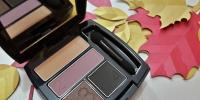Aloe flower: care and maintenance at home
Previously, aloe could be found in almost every home, even our grandmothers grew it as a medicinal plant. Today, interest in the flower has fallen, but it is still considered a home doctor. People call aloe agave or "wound". The most commonly grown aloe tree (Aloe arborescens).
Caring for aloe at home does not require special skills, the plant is unpretentious and grows without requiring special attention. However, neglecting the basic rules of cultivation can lead to disease, wilting and even death of the plant.
Aloe flower is a herbaceous perennial of the asphodel family, belongs to succulent plants. The birthplace of aloe is South Africa, there are about 350 species in total, but only 15 of them are medicinal.
At home, the flower grows up to 70-80 cm, has juicy dull green leaves with thorns (see photo). The lower leaves are considered curative, the juice of the leaves is bitter. It is unlikely that anyone has seen flowering aloe; in the Russian climate, it lacks light and heat.
Aloe is considered a symbol of patience and vitality. Psychologists recommend growing it at home for people with a timid character.
African sorcerers treated wounds from poisoned arrows with aloe juice, prepared wine that prolonged life, and added it to soldiers' drinks.
In Cuba, juice is mixed with rum and sugar and drunk for headaches, the Chinese treat skin diseases with juice, the Filipinos relieve swelling in beriberi disease.
Aloe juice is a powerful antibacterial agent. It stops the growth of staphylococci, dysentery and tuberculosis bacilli, removes toxins in case of poisoning, restores the skin, strengthens the immune system.
Aloe types
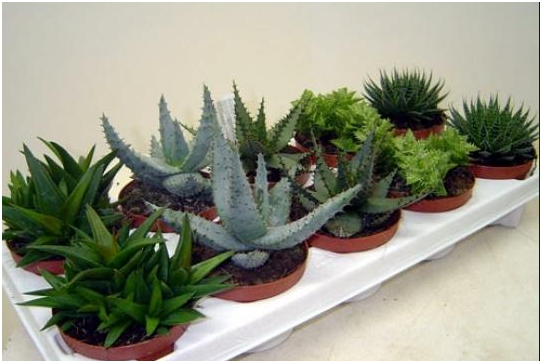
Aloe are divided into plants with an upright stem - tree-like and growing in the form of a rosette - herbaceous.
In addition, there are decorative and medicinal types:
There are varieties with original names: pretty aloe, hedgehog aloe, pretty aloe.
Planting a plant
The soil
The same soil is suitable for aloe as for cacti, so the easiest option is to purchase it in flower shops.
The soil mixture can be prepared by yourself. The composition includes sheet, sod land, sand, charcoal at the rate of 2:3:1:1. It is recommended to add broken white brick or expanded clay to the mixture for better air permeability of the soil.
You can not use peat, because. this is detrimental to the root system. Clay soil is also not suitable, which provokes stagnation of water, which causes root rot.
The composition should not contain nitrogen, it leads to softening and cracking of the leaves, the plant loses its decorative appearance.
Before filling the pot, the soil mixture must be calcined. Drainage material is also disinfected in a solution of potassium permanganate.
The land where succulents grow in nature is sand, stones, lack of fertile soil layers, while good aeration and quick drying of the surface. These points must be followed when growing aloe at home.
Pot selection
The best option for aloe is a wide but shallow clay pot. Before planting, the pot must be calcined in the oven. If a plastic container is used, it should be washed thoroughly with hot soapy water.
Landing: step by step instructions
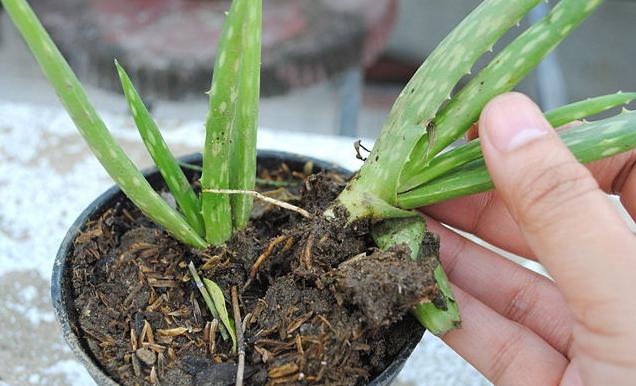
When planting a plant, it is necessary to follow a number of simple rules, since any change in conditions is stress for the plant.
- 10-15 days before planting, we water the aloe so that it can be easily removed along with a clod of earth and not damage the roots
- At the bottom of the pot we lay drainage 7 cm high
- We fall asleep prepared soil to half the pot
- We must remove the old soil from the roots of the plant and place it in a pot so that the root neck is 2 cm below the edge of the pot
- We add earth and fix the plant with pebbles at the base of the stem so that the plant does not collapse.
- Pour expanded clay on top of the soil surface
We put in a shaded place for 5 days and do not water.
Home care
In addition to proper planting, aloe needs proper care.
Ready-made fertilizers and natural organic additives
Top dressing is carried out during the period of active growth from May to August 1 time in 2 weeks. You can use fertilizers specifically designed for succulents, but folk recipes for top dressing are also suitable.
| Fertilizer | Result | Dosage |
| "Power of Life", in a period of growth | Strengthening the root system | ½ tsp for 10 liters of water |
| Bona Forte, during growth | Growth stimulation, photosynthesis acceleration | 5 ml per 1.5 l of water |
| Agricola, in the period of growth in granules or in the form of sticks | Feeding the roots with microelements | 2-2.5 g of granules per 1 liter of water |
| Sugar | Glucose feeding for the formation of new cells | 2 tsp sugar on glass of water |
| Eggshell | Calcium supplement | Pour the crushed shell with hot water in the proportion - 1/5, leave for 2 weeks |
| banana peel | Potassium nutrition | Dried skins are crushed, sprinkled on top of the soil and watered. |
| Potato broth and water after washing cereals | Feeding starch for cell growth | No more than a glass |
| onion peel | Destroys pathogenic microflora | 15 g per 6 liters of boiling water, leave for 2-3 hours |
- Top dressing is carried out only after watering the plant and complete impregnation of the soil.
- Newly planted plants do not need to be fed for 6 months
- Top dressing is applied in liquid form, either on top of the soil or through a pallet, drops should not fall on the stems
- It is better to fertilize in the evening or on a cloudy day.
- Feed only healthy plants
- It is better not to overfeed the plant, the norm is 1-2 times a month
Temperature
The temperature for aloe should vary according to the biological cycle of the plant. The optimum temperature in winter at rest should be + 12 ° C, so it is better for a flower in a cool room. In summer, the most comfortable temperature is 25°C.
Lighting
The plant "loves" an abundance of light, so the best place for it in the apartment is the south side. In winter, many use additional artificial lighting, but this leads to stretching of the leaves and loss of decorative effect.
If there was little light in winter, then in spring the plant is gradually accustomed to the sun's rays, taking it out to the balcony, first for an hour, then for a longer time so that the leaves do not burn.
Watering and humidity
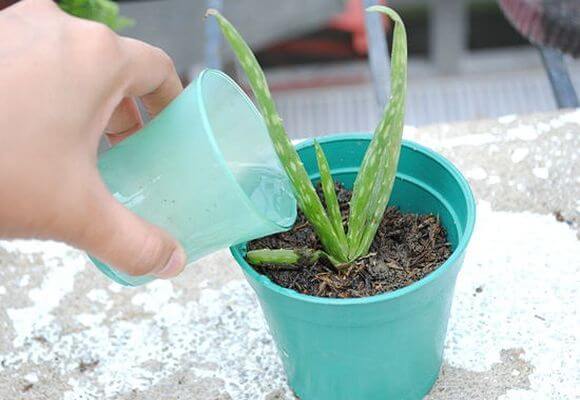 During the growth period - in spring and summer, aloe is watered 1-2 times a week, depending on the drying of the earth. During the dormant period in autumn and winter - 1 time per month is enough.
During the growth period - in spring and summer, aloe is watered 1-2 times a week, depending on the drying of the earth. During the dormant period in autumn and winter - 1 time per month is enough.
Watering is carried out with settled water at room temperature, around the edge of the pot with a watering can with a thin spout, or by pouring water into a pan. Water should not fall on the leaves.
Important! Aloe is forbidden to spray, the leaves are wiped with a damp cloth when dust appears, otherwise they begin to rot.
Airing
Aloe loves fresh air, so many people take it to the balcony in the summer, providing protection from rain and drafts. In an apartment, it is better not to put it under open windows.
Transfer
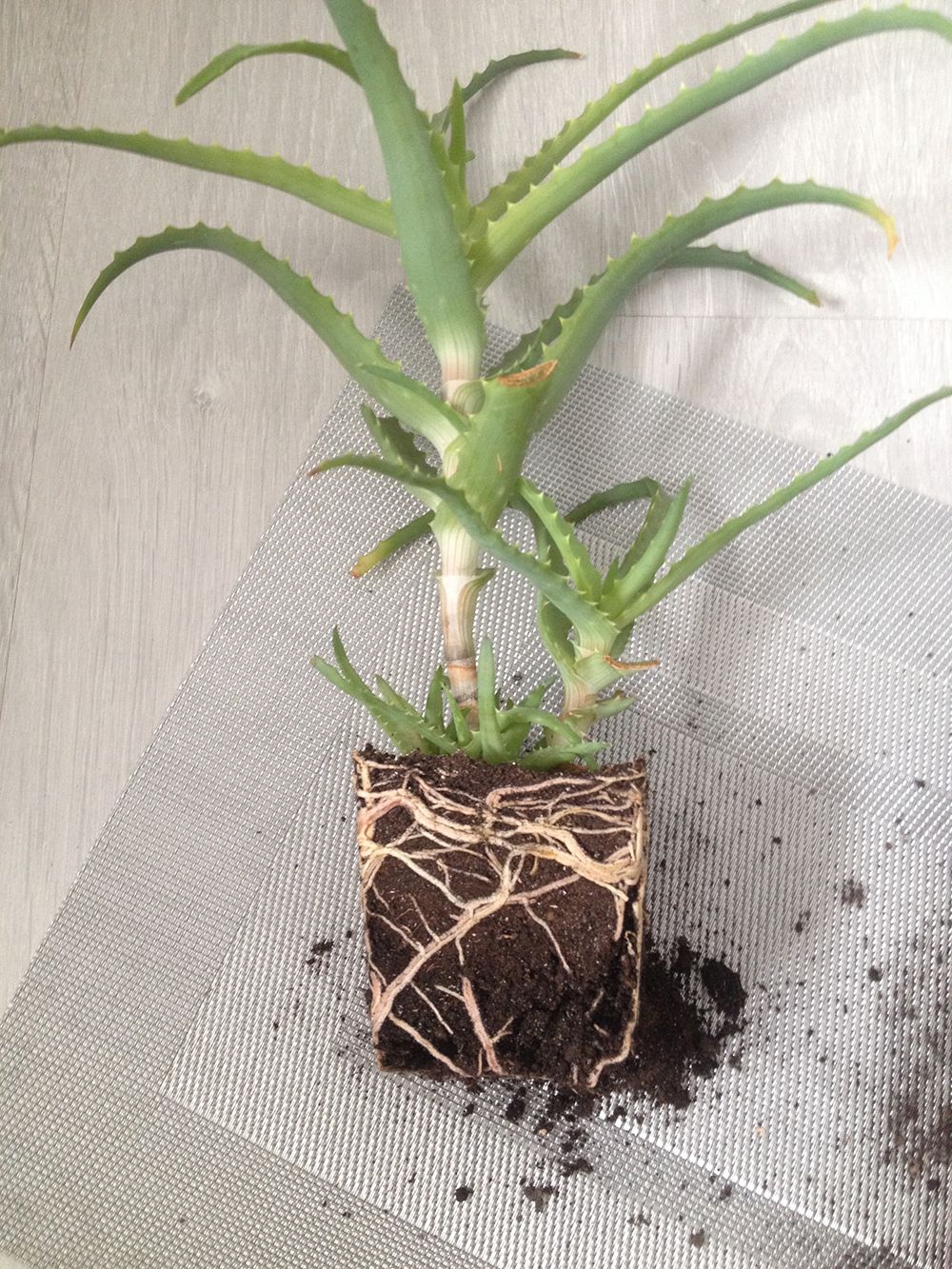 The plant needs to be transplanted every 2 years, increasing the volume of the pot by 20%, it is better to do this in the spring. Determining the need for a transplant is very simple:
The plant needs to be transplanted every 2 years, increasing the volume of the pot by 20%, it is better to do this in the spring. Determining the need for a transplant is very simple:
- The plant stops growing
- In a pot, a woven root ball with almost no soil
- The roots break through the drainage holes in the bottom of the pot.
- Many shoots have grown around the main stem
- The stems lose their even color, dry out
- The leaves are 2 times larger than the diameter of the pot.
Transplantation is carried out according to the same scheme as the planting described above.
pruning
Regular pruning is essential for aloe as a preventative measure for better growth. It is necessary to remove diseased, old and dried leaves, young shoots (kids) that draw juice from the main plant.
Bloom
Most types of aloe plants do not bloom indoors. In the wild, aloe blooms every year with red or yellow flowers collected in a brush.
Propagation of homemade aloe
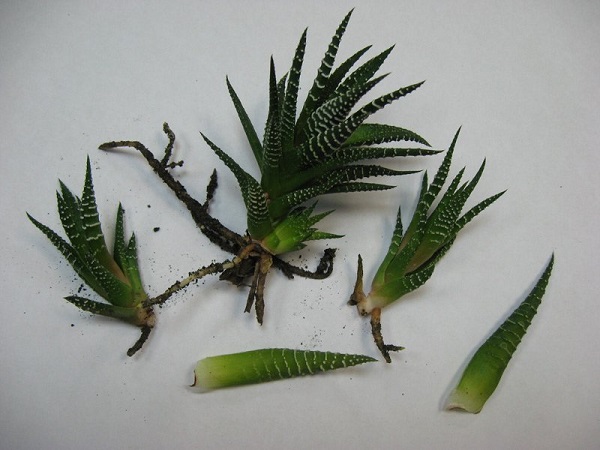
They say about aloe: "put it in an empty glass and forget it - it will grow and not dry out."
Since in our conditions it is difficult to achieve aloe flowering and get seeds, it is propagated by cuttings, leaf plates and children.
- The stalk is cut off with a knife, at least 10 cm long, powdered with ash, and after the cut has dried, after 2-3 days, it is planted in moist soil
- The sheet plate after the cut is placed in water. As soon as the leaf gives roots, it is planted in a permanent place to a depth of 3-4 cm.
- Young shoots already have a root system, so they are immediately planted in a pot
The plant can be propagated only in spring or summer.
Growing problems with improper care
| Signals | Cause |
| Leaf curl | Shchitovka or dustiness of leaves |
| Yellowing leaves | Over watering |
| Dry tips of leaves | The roots are cramped, need a transplant |
| Roots rot | Over watering |
| Aloe not growing | Bad soil or no top dressing |
| stems stretched out | lack of lighting |
| leaf fall | Irrigation with cold water |
| Leaf reddening | Too much sun |
| leaf thinning | lack of lighting |
| Brown spots on the leaf | Sunburn |
Diseases and pests
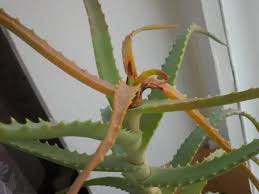 Aloe is a viable flower, but it is also susceptible to disease.
Aloe is a viable flower, but it is also susceptible to disease.
- Root rot is the most common disease that results from overwatering. It is recommended to remove all damaged roots, sprinkle them with ashes and transplant the plant into new soil. Water no earlier than a month later. If the entire root system is affected, the plant cannot be saved.
- Dry rot. The development of the disease occurs without visible signs, the plant dries up from the inside and dies.
The scale prevents the photosynthesis of the plant, as a result, the leaves curl and dry out. Even more dangerous is the false shield, which injects poison into the leaf. It is necessary to wipe the sheets with a cloth soaked in alcohol or vinegar, use the Aktara preparation. Transplant the plant, disinfect the containers.
The spider mite is the main enemy of aloe, it is difficult to notice, the only signal is white spots on the leaves. To fight, use the drug - "Aktelik". As a preventive measure, rubbing the leaves with tincture of garlic.
The mealybug is the easiest to kill. The insect does not like humidity, so you need to wipe each sheet with an vinegar solution or Biotlin.
Growing aloe at home will not be difficult even for a beginner, but it can decorate the house and become a home doctor.


